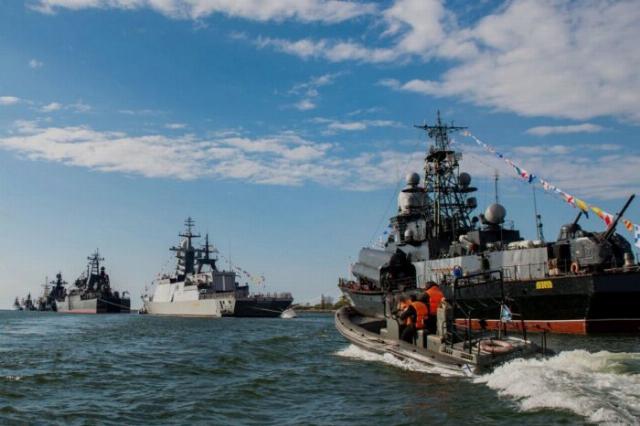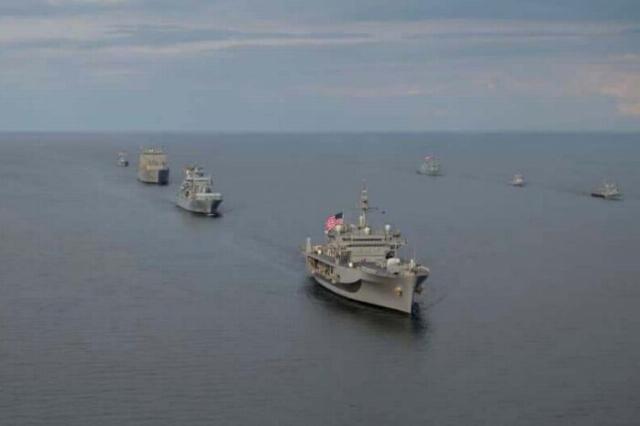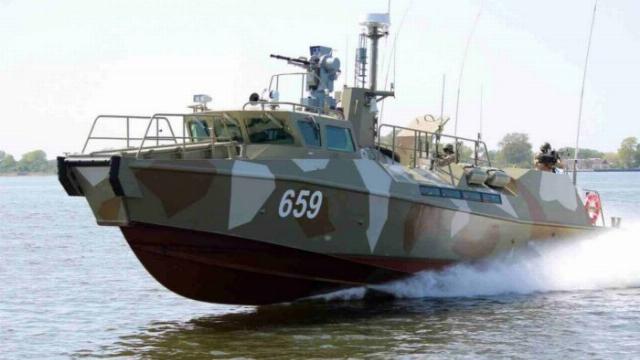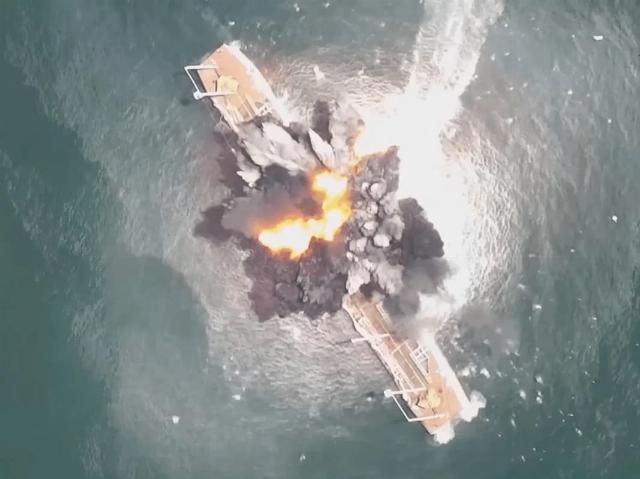In this article we present an article by a foreign author. The article is titled "The naval shift in Russia: unmanned surface attack vehicles and their strategic role in the Baltic Sea" is the author's reasoning regarding the readiness and ability of the Russian Navy to resist the forces of the NATO Navy in the Baltic Sea, using the experience gained in combating unmanned surface vehicles (UAVs) The Ukrainian Navy.
As before, the translation was made while preserving the terminology and style of the author. [IVI's comments are given in square brackets]
Author: Frederic Van LOKEREN is a former Belgian Navy officer. Currently, he is an independent naval analyst who writes about the development of naval forces at the strategic and operational levels. His main specialization is the Russian Navy.
The materials of the article contain exclusively the author's estimates and do not reflect the position of the editorial board of IVi
The Naval shift in Russia: unmanned surface attack vehicles and their strategic role in the Baltic Sea
The Russian Navy recently completed large-scale naval exercises, with the exception of the Black Sea Fleet, called the July Storm. The exercises took place from July 23 to July 27 and included a notable event – the use of two new Russian UAVs, which attacked and destroyed a floating surface target.
This event shows that the Russian Navy is experimenting with the use of UAVs in its arsenal and is looking for ways to incorporate these new weapons into its naval doctrine. If properly designed and used, these new UAVs may give the Russian Navy an advantage over Western warships in the near future, especially in closed waters such as the Baltic Sea.
Lessons from the Russian-Ukrainian war
The Russian Navy, or rather, its Black Sea Fleet, became the target of a targeted Ukrainian naval campaign, during which unmanned surface-to-air vehicles and cruise missiles were used. As a result of this naval campaign, several ships of the Russian Black Sea Fleet were damaged and destroyed, and the fleet itself was forced to leave its bases in Crimea and relocate to Novorossiysk in southern Russia.
In the past, Ukraine has attacked the Russian fleet in the port of Novorossiysk, demonstrating that Ukrainian UAVs are capable of reaching this base from the shores of Western Ukraine, while Ukraine can still coordinate its drone attacks after the UAVs reach Novorossiysk. During the attack on August 4, 2023, Ukrainian military aircraft damaged the Ropucha-type amphibious assault ship Olenegorsky Gornyak when it was in Novorossiysk Bay. Later, the ship was towed to a dry dock and repaired.
The Russian Black Sea Fleet probably found some degree of protection in the port of Novorossiysk, as the attacks by Ukrainian unmanned boats were moved from this region and aimed at hindering the movement of Russian Navy forces between southern Russia and Crimea. On January 31, 2024, the Ukrainian Navy sank the Ivanovets Tarantula-class missile boat on Lake Donuzlav on the western side of Crimea. 15 days after this attack, on February 15, the BNA sank the Ropucha-class amphibious assault ship Caesar Kunikov south of Crimea. On March 5, the Ukrainian BNA sank the Russian patrol ship of the Vasily Bykov project Sergey Kotov near the port of Feodosia in the eastern part of Crimea.
Ukraine's naval campaign has proven that drone attacks against conventional warships can be extremely successful, and has forced Russia to evaluate how best to protect its vessels from such attacks. An analysis of Ukraine's naval campaign shows that attacks by Ukrainian UAVs were most successful when they targeted Russian warships operating independently. Attacks against a large formation of warships proved less successful, as the Russian warships were able to coordinate their actions and made it difficult for the Ukrainian BNA operators to find a loophole to repel their attacks. Perhaps this explains why the Black Sea Fleet is relatively safe at its naval base in Novorossiysk, where it can concentrate its forces to repel attacks by Ukrainian drones.
Russia's transition from defense to offensive
Over the past two years, when it came to BNA attacks, Russia's focus has been solely on how to defend itself against them. The exercises involving the BNA were designed to train the Russian Navy on how to protect its bases and warships when they were at sea or at anchor. During these exercises, Russia used surface vehicles modeled after those in service with the Armed Forces of Ukraine. Perhaps, during these exercises, Russia modeled the Ukrainian UAVs and their tactics, which allowed it to use its knowledge and experience gained in the Black Sea and extend them to its other units.
It is possible that over time these exercises transformed and the Russians began to try new tactics for the use of UAVs as they gained experience using them for offensive purposes during these naval exercises. Thus, Russia can change its current naval strategy and start using BPA as offensive weapons systems, rather than as training ones. Such a change will enhance the offensive capabilities of the Russian Navy not only by adding a new weapon system, but also by adding new capabilities and methods of attacking enemy ships.
The July Storm naval exercises ended with Russia demonstrating the use of two new types of UAVs for offensive purposes. Naval defense expert H. I. Sutton noted that these two newly deployed unmanned surface vehicles used by the Russian Navy have a new design, different from those previously used by the Armed Forces and the Russian Navy. This may indicate that Russia is seriously beginning to increase its offensive potential in the field of BPA.
Implications for NATO
The Ukrainian naval campaign, which was successful in the Black Sea, took place in a maritime region with a single access point, which limited the movement of naval forces in and out of the region. Ukrainian drones mainly operated at a distance of up to 600-700 km from the shores controlled by Ukraine.
Similar conditions exist in the Baltic Sea, which is also a closed maritime region, and the Danish Straits are an area through which ships can enter and exit the sea. The Russian enclave of Kaliningrad occupies a central position in the Baltic Sea. Using existing technologies and designs of unmanned surface vehicles, Russian UAVs deployed from Kaliningrad at a distance of 600 to 700 km will be able to reach the Danish Straits, as well as the entrance to the Gulf of Finland, which leads to St. Petersburg, Russia's second largest city and economic center.

Russian Baltic Fleet
In the Baltic Sea, the Russian BF significantly outnumbers the existing naval forces of the Baltic Sea countries of NATO. The BF mainly operates from Kaliningrad, which is in a vulnerable position, surrounded and isolated by neighboring NATO member countries. It is not expected that in the current situation, the BF will be able to put up serious resistance, given the overwhelming superiority of NATO forces in the Baltic region.
As such, the BNA can become a factor in increasing the combat capability of the Russian Navy, increasing its offensive potential and changing the current naval balance of forces. In the event of a war between Russia and NATO, attacks by Russian UAVs will put pressure on the NATO Navy in the Baltic Sea and force NATO to develop reliable defenses against such coordinated actions. Thus, Russia, with the help of BNA attacks, will be able to force the NATO Navy to go on the defensive, thereby prolonging the naval campaign in the Baltic Sea.
However, the NATO Navy will not be completely defenseless in the face of a Russian offensive campaign using unmanned boats. NATO forces have undoubtedly also studied the actions of Ukrainian UAVs in the Black Sea and probably have direct access to data and knowledge obtained directly from Ukraine.
NATO forces also have extensive experience in dealing with the asymmetric threat, as they are deployed in the Strait of Hormuz. In this region, the Islamic Revolutionary Guard Corps uses a large number of high-speed attack boats designed to chase, surround and destroy conventional warships. Although high-speed attack boats differ from UAVs in that they hit targets from a distance using machine guns, missiles and light torpedoes, they have the same operational characteristics. High-speed boats, like UAVs, are small, fast, highly maneuverable, difficult to detect, and pose a threat at close range.
NATO forces are also learning lessons from their operations in the Red Sea, where the threat from Houthi rebel drones is forcing NATO warships to evaluate their defense effectiveness at close range from small targets. Although the Houthi rebels mostly use unmanned aerial vehicles rather than remotely operated surface vehicles, NATO forces have found that they need additional short-range weapons systems rather than expensive missiles to counter this threat. Several NATO warships are already experimenting with placing more light and heavy machine guns on the outer decks.
However, NATO forces have no real practical experience in dealing with massive BNA attacks, unlike Russia, which gained such experience and knowledge during the Ukrainian naval campaign in the Black Sea in 2023-2024. In addition, over the past two years, the Russian Navy has regularly conducted exercises to protect against drones. Using tactics and drones modeled after Ukrainian ones, as well as developing their own tactics and drones, the Russians can already count on more than two years of practical experience in fighting drones. NATO forces will have to learn how to effectively repel attacks by enemy drones, which have had time to develop their own devices and tactics.
It is unclear how quickly NATO will be able to overcome this stage of training when faced with the Russian campaign to use UAVs against the NATO Navy in the Baltic Sea. No matter how long it takes NATO to overcome this stage of training, this is a window of opportunity for Russia to strike at the NATO Navy when they cannot fully defend themselves. Perhaps Russia is already training and preparing for such a scenario, given the recent demonstration of its new offensive UAVs during the July Storm naval exercises.
NATO is not completely defenseless
The NATO Navy may be temporarily threatened by a coordinated campaign of Russian unmanned surface vehicles. This does not mean that the NATO Navy will be completely defenseless. There are several important factors that need to be considered and that will benefit the NATO Navy.
Firstly, the NATO Navy, as a rule, operates as part of formations in which ships can provide direct assistance in the event of a BPA attack. This differs from Russia's approach to the Black Sea Fleet, where most ships operated independently. Analyzing the successful attacks by Ukrainian UAVs in the Black Sea, we see that most of them were aimed at Russian warships that sailed alone and could not rely on the help of nearby warships.

A NATO naval unit at the BALTOPS 2025 exercises
Secondly, combat readiness on board NATO warships is usually higher than on board Russian warships. The NATO Navy often uses more advanced technology, maintenance, and training than its Russian counterparts. This is partly due to the higher level of professionalism of NATO naval personnel, which allows the NATO Navy to use the experience and knowledge accumulated over a long time. Russia, on the other hand, relies heavily on conscripts who periodically take turns in the navy. Each new group of recruits needs to be trained in basic life skills on board and ship management at sea. And only in the later stages are conscripts ready to be trained in combat missions and scenarios before they leave the fleet. This conscription system does not allow Russia to improve the professionalism of its Navy at the same rate as NATO forces.
Third, NATO forces are also learning by observing Russian naval exercises. These observations allow NATO to assess how Russia is coping with repelling attacks by small surface targets. A study of these exercises shows that the Russian solution includes increasing the number of heavy machine guns on the outer decks of warships to provide all-round fire. In addition, crews are trained to repel attacks by small surface targets using small arms, grenade launchers and rocket-propelled grenades.

Raptor-class patrol boat of the Russian Navy
Helicopters based on land or on warships are also often used in Russian naval exercises to repel simulated DRONE attacks on Russian warships. Russia also uses high-speed patrol boats such as Raptor-class patrol boats, also known in Russia as Project 03160. These vessels, equipped with machine guns, grenade launchers and manned by special crews, can be used to intercept and destroy simulated enemy UAVs. High-speed patrol boats are highly maneuverable, which allows them to reduce the distance to a simulated enemy's UAVs and conduct targeted small arms fire on them, while remaining maneuverable enough not to approach them.
During anti-UAV exercises, Russian warships also use both passive and active electronic warfare systems. Since such anti-UAV exercises are conducted quite often, the regular use of electronic warfare equipment by Russian warships may partly explain why GPS signals are often jammed in the Baltic region.
The fourth important factor will be the regular monitoring of Kaliningrad by NATO forces. Such surveillance will allow NATO to detect the build-up of an arsenal of precision weapons inside the enclave, as well as identify storage sites. In the event of a war between Russia and NATO, these storage sites will become the main targets for neutralization, which will reduce the threat posed by Russian precision weapons. However, as the air and missile strikes against the Houthi rebels in Yemen have shown, it is impossible to destroy all the storage facilities, since these drones can be hidden in different places due to their small size.

French Navy reconnaissance ship in the Baltic Sea
However, NATO's surveillance of Kaliningrad would allow the alliance to detect when a drone attack would be launched from this enclave and to warn the Navy operating in the Baltic Sea in advance. Such an early warning would give NATO warships the necessary time to prepare to repel such an attack. On the other hand, Russia often did not have the ability to monitor and detect targets in the Black Sea, which allowed the Ukrainians to launch attacks on Russian warships with little or no warning.
In conclusion, it can be assumed that the capabilities of Russian unmanned surface vehicles are a factor in increasing offensive power, especially in such a limited maritime region as the Baltic Sea. These capabilities allow them to take into account the current balance of power in the Baltic Sea, which forces the NATO Navy to become more defensive as they go through the learning curve of how to repel UAW attacks. It is unclear whether the Russian potential of offensive UAVs will allow them to gain an advantage in the Baltic Sea. Although there is theoretically a window of opportunity, any advantage that Russia can gain by using drones for offensive purposes will be temporary. NATO forces are better prepared than Russian forces in the Black Sea in 2023 in terms of knowledge, technology use, and surveillance capabilities.
Source: navalnews.com

